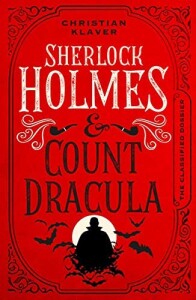 Christian Klaver’s Sherlock Holmes & Count Dracula is a mashup of two of the most well known figures in the history of publishing. While these two characters have been often combined, the myriad ways it can be done will mean a great deal of interest for new interpretations.
Christian Klaver’s Sherlock Holmes & Count Dracula is a mashup of two of the most well known figures in the history of publishing. While these two characters have been often combined, the myriad ways it can be done will mean a great deal of interest for new interpretations.
This volume, like many others, chooses to make a change by making Dracula something of a protagonist rather than enemy. His vampiric nature still exists, and the fact he has made a number of different criminal actions over the course of his immortal life are undeniable.
Amusingly, Bram Stoker’s book explicitly exists in the universe of this text, as do a number of other works of fiction that are referenced in a factual manner throughout the book. This leaves all of the characters in the unusual position of having to explain the fact the books exist. With another mashup of existing properties this might strain the suspension of disbelief, yet with Sherlock Holmes and his close friend Doctor John H. Watson on the case, it actually seems only appropriate.
Sherlock Holmes comes to accept the existence of vampires in a fashion entirely fitting of the character. Specifically, he does so due to his scientific studies upon what turns out to be the tissue of a vampire’s severed finger. Seeing violent reactions to silver and sunlight, combined with traits similar to hemophilia, would likely cause anyone to consider that there must be a level of reality to the myth.
This knowledge is quickly confirmed by the arrival of none other than Dracula himself in Baker Street, where he wishes to make inquiries as to the whereabouts of his wife Mina. This is another common but not always accepted deviation from the original novel, and how one feels about it will obviously effect the opinion of this volume as a whole.
Truthfully, it is the treatment of Mina and of Watson’s wife Mary that are probably the most troubling aspects of this book. Mina spends a large portion of it in need of rescue and out of sight. While something similar happens in the original novel, it is to a lesser extent and the woman is given much more chance to show her mettle even while the plot is centered on protecting and saving her. Here she is entirely without agency until after rescue. Mary is given a notably different fate here than the one mentioned in “The Empty House” and it paints her more darkly. While the chances seemed high that this merely coincidental, and figures like Kitty Winter working with Sherlock Holmes serve to help, it is still noticeable that two women from Victorian literature get this treatment.
Like many a pastiche, the irregulars appear. Mycroft plays a role (albeit offscreen) and certain old antagonists return. While this has been done well and poorly in the past, the return of these characters at once might seem a case of “small world” to some readers regardless. The execution here is at the very least impressive and well integrated.
It should be noticed that this book is intended as the first in a series called The Classified Dossier. There is definite potential in that regard, with offhand mentions and detailed passages both relating back to other types of supernatural occurance. A series is thus almost expected by the end of the book, regardless of the overall plans by the publisher or author.
Overall Sherlock Holmes & Count Dracula is a most enjoyable romp. While straying rarely into the realm of true horror, the book is liable to keep interest. If one enjoys combining Sherlock Holmes with the traditional supernatural, this is easy to recommend.
(Titan, 2021)
